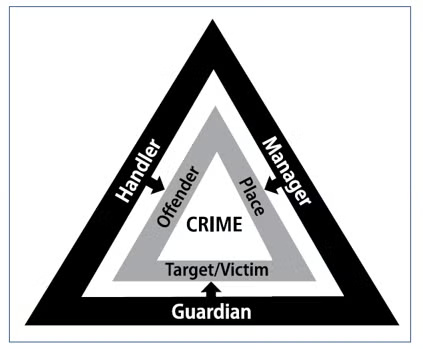
Center for Problem-Oriented Policing
Monitoring Offenders on Conditional Release
Response Guide No. 12 (2016)
by Lacey Schaefer, John E. Eck, and Francis T. Cullen
Introduction
The routine convergence of three elements is necessary for a persistent crime problem: offenders, targets, and places. In addition, people who would normally prevent those crimes—controllers—must be missing or ineffective. This basic formula is often depicted by the crime problem triangle (see Figure 1). The elements in the inner triangle are necessary for crime, and the controllers in the outer triangle are sufficient for the prevention of crime. Police and researchers have developed and tested a variety of prevention options for all six elements.
The Goals of this Guide
This guide focuses on offenders; specifically, people who have already been convicted of crimes and who are under community supervision ordered by courts or correctional authorities. Although many of these individuals are not actively engaged in offending, the past behavior of people on probation and parole suggests that they have a heightened risk of committing a crime. Consequently, reducing the risks of offending for people on probation and parole can be an ingredient in sustainable solutions to crime problems.
In this guide we discuss how offenders are supervised by correctional agencies while on community release. These offenders can cause problems for police (e.g., recidivate and prompt calls for service), so understanding community supervision can be extremely useful for solving such problems. This response guide provides a review of the most effective practices for monitoring offenders on conditional release. For police and their partners, this will help them better understand community supervision, and appreciate the benefits and potential hurdles in their collaborations with community corrections agencies. For probation and parole authorities, this guide may help them develop an understanding of the ways police officers can assist offender supervision and community reintegration.
Figure 1. The Crime Problem Triangle

Police Interests
There are four reasons why offenders under community supervision are important to police:
First, individuals on probation and parole have an elevated risk of recidivism. Knowing that this population of people is more likely to commit crime than the general population makes them a group of concern.
Second, offenders on supervised release reside in the community instead of jail or prison. As such, individuals on probation or parole will be tempted by accessible targets or facilitating crime places. As the police seek to make targets less vulnerable and places less conducive to crime, addressing offenders under community supervision can also be an important component to reducing crime problems. While corrections agencies focus on court compliance and rehabilitation after the crime, the police have a distinct interest in preventing crime.
Third, the police represent the best line of defense in protecting victims and witnesses in criminal court cases. Doing so requires that the police are knowledgeable of community supervised offenders in their jurisdiction.
Fourth, these offenders are known; criminal justice agencies have some control over them, and the police in particular have leverage over offender conduct. This is important if there is reason to believe such offenders are connected to the crime problem being addressed. If they are, then police agencies should enlist another set of partners—probation and parole authorities—in their crime prevention efforts.
For these reasons, police departments may be interested in collaborating with community corrections agents. Yet in order to effectively partner with community correctional authorities, police need to know what strategies work. What sorts of supervision can curtail crime and what sorts may increase crime? What services are effective at curbing offending and what programs are ineffective? Researchers have come a long way in uncovering effective practices in deterring and treating offenders—not 100 percent of the time, but better than past alternatives. Equally important, we also know what practices do not work well.
This guide reviews such information, providing police with an overview of the best practices for managing offenders in the community. Specific recommendations for police wishing to partner with probation and parole authorities are also provided. A later section discusses strategies for use with special populations of offenders under community correctional control; however, the guide is written with a special emphasis on adult probationers and parolees that are at a high risk of committing additional crimes.
To be clear, we are not advocating that police departments assist in the monitoring of all offenders under community correctional supervision. However, some offenders on probation and parole are central contributors to common crime problems that police try to solve. As such, police departments may find it helpful to collaborate with formal offender supervisors. Although police officers will have a narrow role to play in preventing crime among high-risk probationers and parolees, it is important that they have a working appreciation for the larger goals of community supervision and the different strategies used to accomplish these goals. Only then can the research on the effectiveness of different offender monitoring tactics be presented to them, including specific recommendations tailored for how the police can best help.